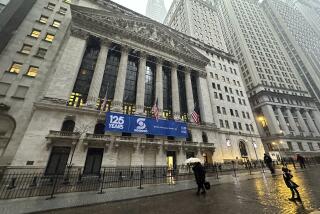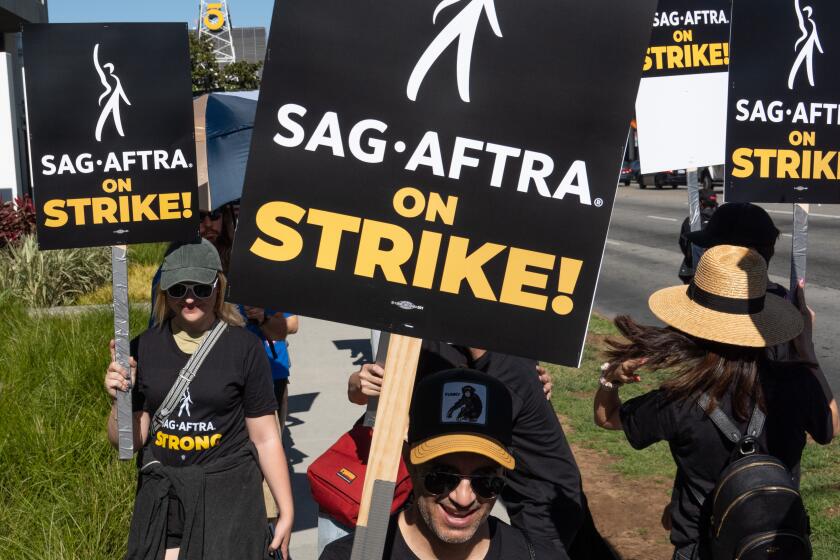Market rallies behind bank rescue plan
The Obama administration’s long-awaited plan to cleanse banks of rotten investments tied to bad home loans scored a big win on Wall Street on Monday as investors bet that the government may have finally found a way to fix the nagging problem at the core of the financial crisis.
The Dow Jones industrial average soared nearly 500 points after Treasury Secretary Timothy F. Geithner detailed the administration’s innovative but untested plan for the government to invest alongside private firms to buy as much as $1 trillion of the troubled assets clogging the balance sheets of financial institutions.
Skeptics said it wasn’t clear that enough investors would step up -- or that banks would be willing to unload assets at the prices offered. But a banking trade group sounded a note of optimism. And some of the country’s biggest investment firms expressed support for the program and said they planned to participate.
“This is perhaps the first win-win-win policy to be put on the table,” because investors, struggling banks and taxpayers all could come out ahead under the plan, said Bill Gross, co-chief investment officer of money management giant Pimco in Newport Beach.
The assets to be acquired consist of individual home loans as well as securities backed by pools of mortgages. Those assets have plummeted in value since the housing market peaked, eating into banks’ capital and making them less willing to lend money and less able to raise new capital.
By giving the banks a way to unload the assets, the Obama plan could boost available funding for all kinds of loans.
“We believe that this is one more element that is going to be absolutely critical in getting credit flowing again,” President Obama said. “It’s not going to happen overnight. There’s still great fragility in the financial systems. But we think we are moving in the right direction.”
Under the complex plan, the Treasury Department would use $75 billion to $100 billion from its $700-billion financial-system rescue fund to invest in a series of joint ventures with private investors.
With low-cost government financing -- loans from the Federal Reserve or loan guarantees from the Federal Deposit Insurance Corp. -- the joint ventures would buy as much as $500 billion in bad subprime mortgages, mortgage-backed securities and other troubled assets. Geithner said the size of the program could be doubled to buy $1 trillion in assets.
Because it uses the existing authority of the Fed and the FDIC to provide financing, the plan does not require congressional approval -- a plus given the anti-bailout mood prevailing on Capitol Hill. The FDIC brings to the table its experience in selling the financial assets of failed banks.
The low-cost financing boosts the likelihood that investors will offer prices high enough to coax banks to rid themselves of the assets, but low enough for the investors and taxpayers to profit as the underlying loans are collected or sold over time, Pimco’s Gross said.
Meanwhile, the joint-venture setup means the government would share with private investors the risks of losing money on the assets and the potential gains if they rebound in value, as many analysts expect. And the prices to be paid would be set by the market.
“A principal virtue of this mechanism is to use the financial interests of investors to help set the price. Because they have money at risk, they’re going to make better judgments about how to set the price for these assets than the government could hope to make,” Geithner said. “We have seen, and I expect to see, a lot of interest from the private sector.”
Scott Talbott, chief lobbyist of the Financial Services Roundtable, a trade group, said the plan would determine market prices for the assets even if it isn’t widely used, resolving the main reason they are not selling now.
The assets are toxic not “because they have no value; they’re simply toxic because they have no market, and because there is no market we don’t know what the price is,” he said.
“The proposal today cuts the Gordian knot and provides an elegant solution to an elusive problem.”
But the anti-Wall Street sentiment that has swept Congress could scare away investors who worry about being roped into the backlash against executive compensation, experts said.
“That just made a lot of investors very nervous about playing in this game,” fearing that the government would rewrite the rules after the program was up and running, said Bert Ely, an independent banking consultant.
Geithner on Monday tried to ease such concerns, making it clear that big firms that partner with the government to buy troubled assets would not be subject to federal oversight of what they pay their employees, except banks that have gotten capital infusions from the government.
To get investors to join with the government and take the risk of buying the bad assets “will require confidence among investors [that there are] clearly established rules of the game consistently enforced going forward,” Geithner said.
A number of people in the financial industry predicted many investment firms would participate.
“This might make sense for us and be attractive for our investors,” said Steven Persky, chief executive of Dalton Investments, a Los Angeles-based hedge fund. “It’s a lot more effective than what’s been tried so far, which has been to throw money at financial institutions.”
Pimco and New York-based fund manager BlackRock Inc. said they might even create retail mutual funds that would buy mortgage assets under the program, allowing individuals to potentially profit from any increase in value.
About $270 billion remains in the Treasury’s rescue fund. Geithner said the administration hoped that would be enough, but Obama has included in his 2010 budget a potential request for an additional $750 billion.
For taxpayers, one key risk is that the government’s willingness to invest alongside investors -- and to provide hundreds of billions of dollars in financing for the purchases -- could encourage investors to overpay for bank assets because their own risk is relatively modest.
“We simply don’t know whether the assumption underpinning the whole plan -- that the toxic assets have a long-term value significantly greater than current market prices -- is correct,” said Ian Shepherdson, chief U.S. economist at High Frequency Economics in Valhalla, N.Y.
Still, he said, what’s more important to the economy in the long run is whether the program revitalizes banks and spurs them to make new loans.
Nationalizing troubled banks would be a faster way to fuel new lending, but the administration seems determined to avoid nationalization “at all costs,” Shepherdson said.
“If the latest plan does not work, however, they won’t have much choice,” he said
--
tom.petruno@latimes.com
Times staff writer Walter Hamilton contributed to this report.
--
(BEGIN TEXT OF INFOBOX)
Highlights
of the program
Here are the main details of the Treasury’s program to buy troubled mortgage assets from banks and to encourage them to revive lending.
Joint ventures: The Treasury would initially put up $75 billion to $100 billion with an equal amount from private investors to acquire as much as $500 billion in home loans and mortgage-backed securities. The program could eventually acquire a total of $1 trillion in assets.
Home loans: The government plans to encourage hedge funds, pension funds, insurance companies and other investors to buy bank loans in partnership with the Treasury. The Federal Deposit Insurance Corp. would guarantee loans to finance the purchases.
Mortgage-backed securities: The government and private investors would put up equal amounts of capital in five new professionally managed funds. The Federal Reserve and/or the Treasury would supply loans to finance the transactions.
Source: Treasury Department
--
(BEGIN TEXT OF INFOBOX)
How the plan would work
Here is an example of how the Treasury Department’s toxic-asset program would acquire individual home loans.
A bank with a pool of residential mortgages valued at $100 could place those up for sale through the Federal Deposit Insurance Corp.
Private-sector firms would bid to buy the loans along with the government. If the highest bid is, say, $84, the public-private buyer would get a $72 loan. The interest rate would be low because the loan would be guaranteed by the FDIC.
Of the remaining $12 of the purchase price, the Treasury Department and the private investors would each put up $6. The private investors would manage the pool of assets.
The government and the private investors would share in the profits when the assets were sold at a later date.
Source: Treasury Department







